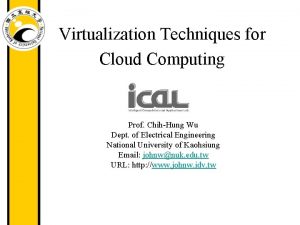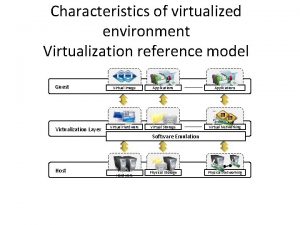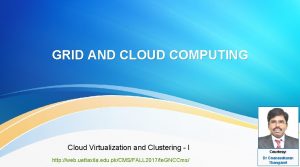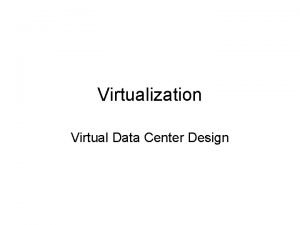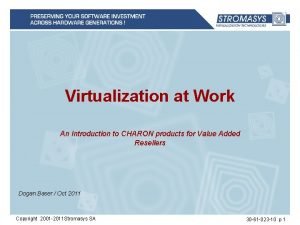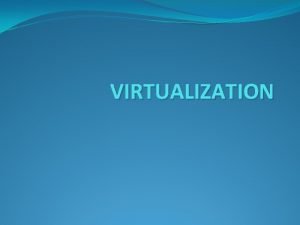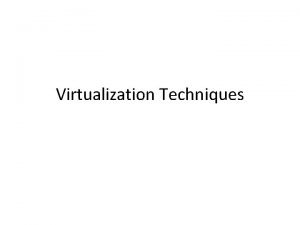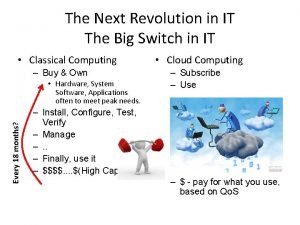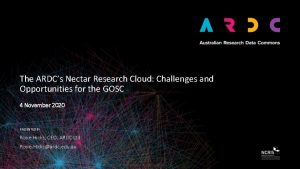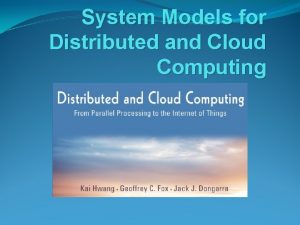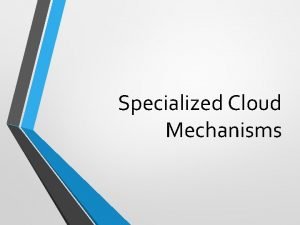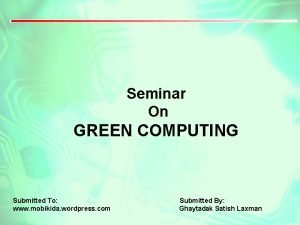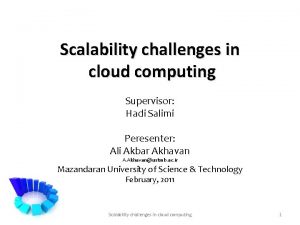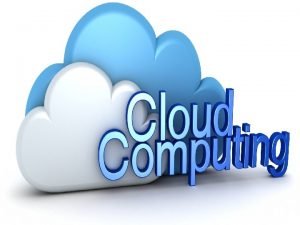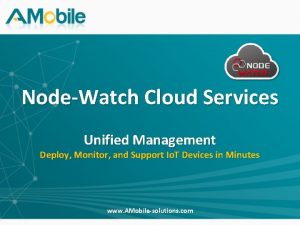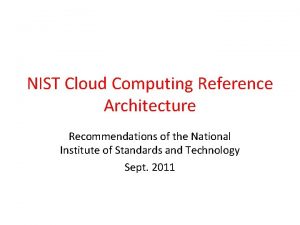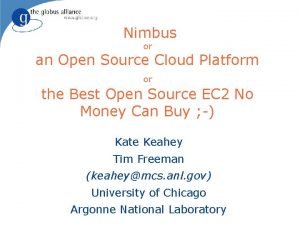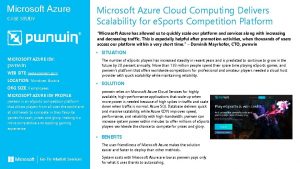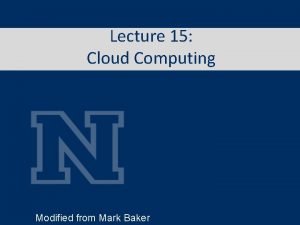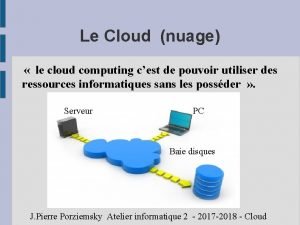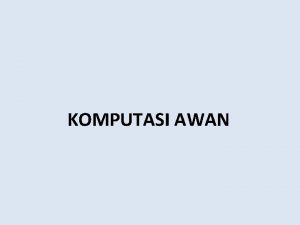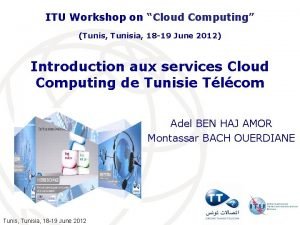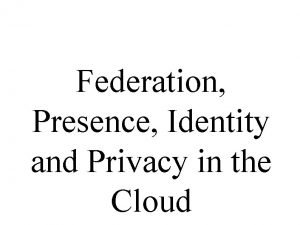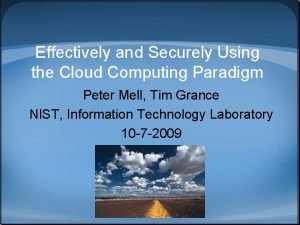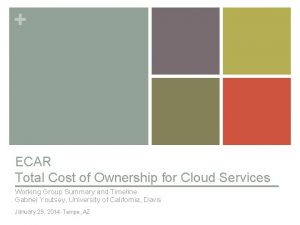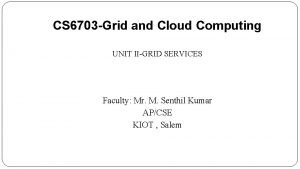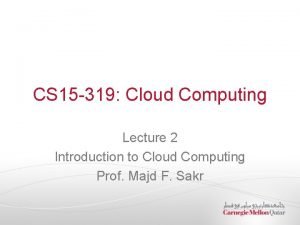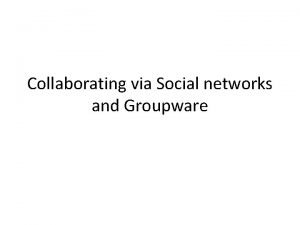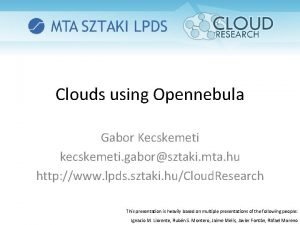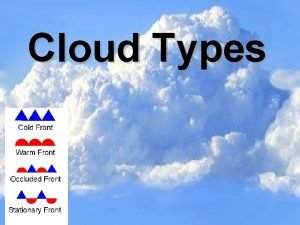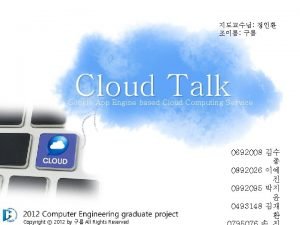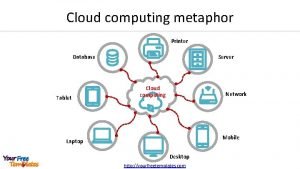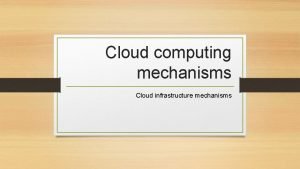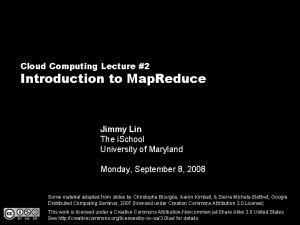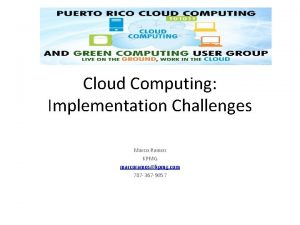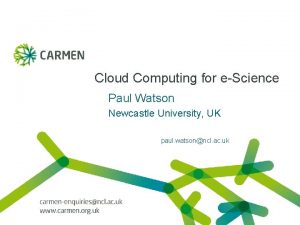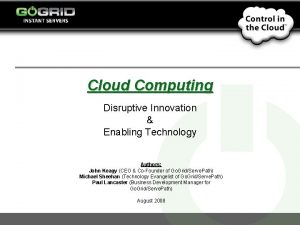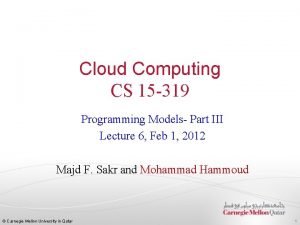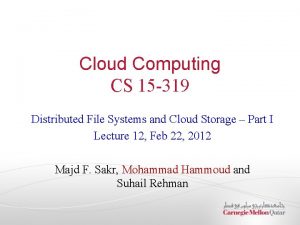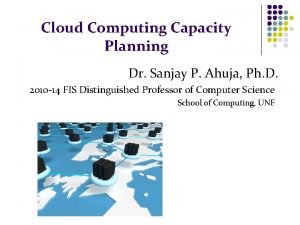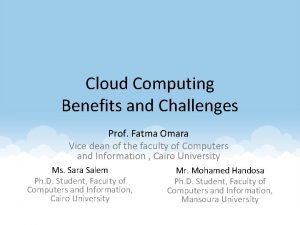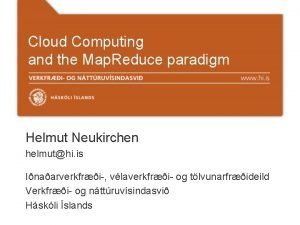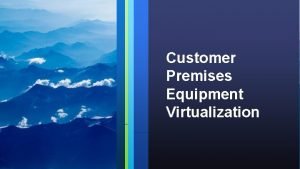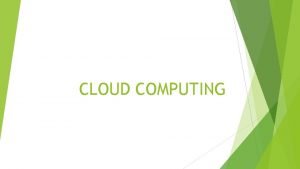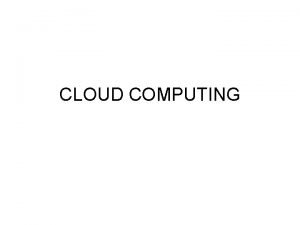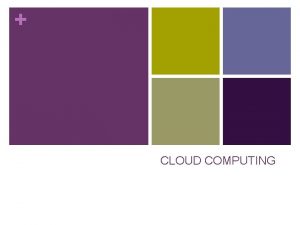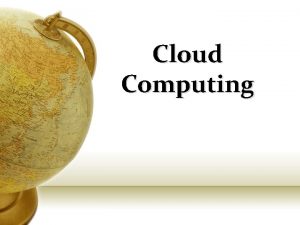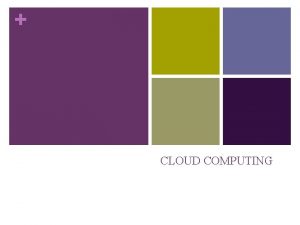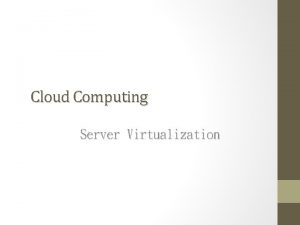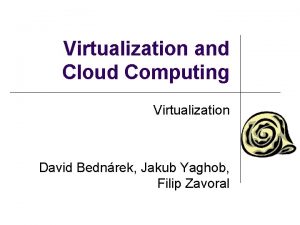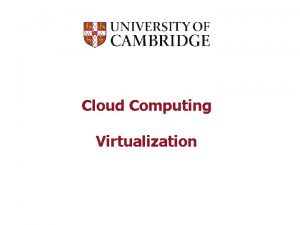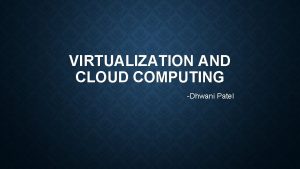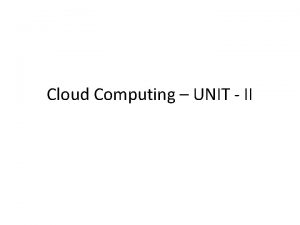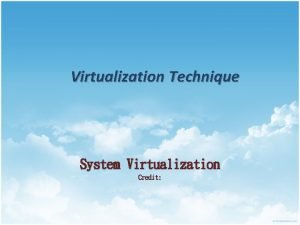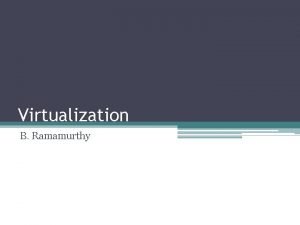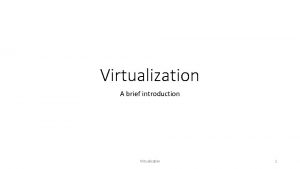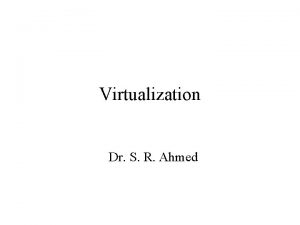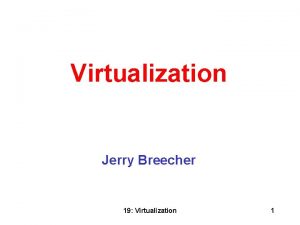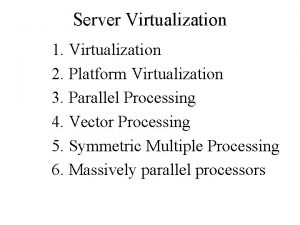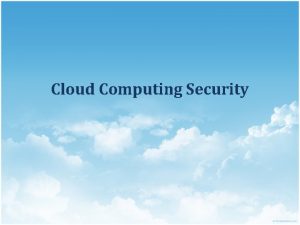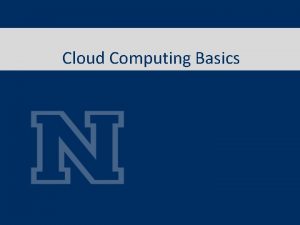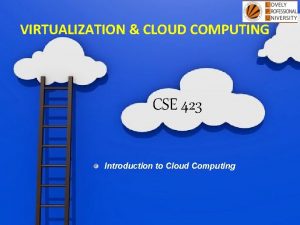Virtualization Techniques for Cloud Computing Prof ChihHung Wu
















































- Slides: 48

Virtualization Techniques for Cloud Computing Prof. Chih-Hung Wu Dept. of Electrical Engineering National University of Kaohsiung Email: johnw@nuk. edu. tw URL: http: //www. johnw. idv. tw

ICAL Outline • • • The needs of virtualization The concepts Types of virtualization Issues in virtualization Implementation cases Conclusion

ICAL In the computer-age…

ICAL A Lot of Servers/Machines. . . • • Web server Mail server Database server File server Proxy server Application server …and many others

A Lot of Servers/Machines. . . • The data-centre is FULL – Full of under utilized servers – Complicate in management • Power consumption – Greater wattage per unit area than ever – Electricity overloaded – Cooling at capacity • Environmental problem – Green IT ICAL

ICAL Virtualization • Virtualization -- the abstraction of computer resources. • Virtualization hides the physical characteristics of computing resources from their users, be they applications, or end users. • This includes making a single physical resource (such as a server, an operating system, an application, or storage device) appear to function as multiple virtual resources; it can also include making multiple physical resources (such as storage devices or servers) appear as a single virtual resource.

ICAL The Use of Computers Applications Operating System Hardware

ICAL Virtualization Applications Operating System Hypervisor Hardware

ICAL Virtualization -- a Server for Multiple Applications/OS Applications Operating System Applications Application Operating System Operating System Hypervisor Hardware Hypervisor is a software program that manages multiple operating systems (or multiple instances of the same operating system) on a single computer system. The hypervisor manages the system's processor, memory, and other resources to allocate what each operating system requires. Hypervisors are designed for a particular processor architecture and may also be called virtualization managers.

ICAL Capacity Utilization Virtualized system (high) High utilized* Low utilized Stand alone system (low) * But not overloaded…

ICAL Why now? • 1960— 1999 – IBM, CP-40, CP/CMS, S/360 -370, VM 370, Virtual PC, VMware • 2000— 2005 – IBM z/VM, Xen • 2006 – Intel VT-x – AMD’s AMD-V • 2008—

Hardware evolution • Faster CPU clock than ever – Though almost hit its top • More CPU cores in a single chip – 4 -core CPUs already in the market – 6 - or 8 -core CPUs will be there soon • Multi-core architectures make parallel processing more realizable • Virtualization support on chip from CPU manufacturers (e. g. , Intel, AMD) ICAL

ICAL Software maturity • More than one credible player in the market • Available and stable open-sourced software – OS, DB, Web server, Java, PHP, gcc, etc. • Established and mature software standards – Web service, XML, SOAP, COM, etc.

ICAL Types of Virtualization • • • Virtual memory Desktop virtualization Platform virtualization – Full virtualization – Paravirtualization – Hardware-assisted virtualization – Partial virtualization – OS-level virtualization – Hosted environment (e. g. User-mode Linux) • • • Storage virtualization Network virtualization Application virtualization. Portable • In this talk, we mainly focus on Platform virtualization which is mostly related to cloud-computing – – – Full virtualization Binary transaltion Hardware-assisted virtualization Paravirtualization OS-level virtualization Hosted environment (e. g. User-mode Linux) application – Cross-platform virtualization – Emulation or simulation – Hosted Virtual Desktop Category in Wiki – Hardware level – Operating system level – Application level

ICAL Full Virtualization • A certain kind of virtual machine environment: one that provides a complete simulation of the underlying hardware. • The result is a system in which all software (including all OS’s) capable of execution on the raw hardware can be run in the virtual machine. • Comprehensively simulate all computing elements as instruction set, main memory, interrupts, exceptions, and device access. • Full virtualization is only possible given the right combination of hardware and software elements. • Full virtualization has proven highly successful – Sharing a computer system among multiple users – Isolating users from each other (and from the control program) and – Emulating new hardware to achieve improved reliability, security and productivity.

ICAL Full Virtualization • It needs a single machine that could be multiplexed among many users. Each such virtual machine had the complete capabilities of the underlying machine, and (for its user) the virtual machine was indistinguishable from a private system. • Examples – First demonstrated with IBM's CP-40 research system in 1967 – Re-implemented CP/CMS in IBM's VM family from 1972 to the present. – Each CP/CMS user was provided a simulated, stand-alone computer.

ICAL Full Virtualization • Virtualization requirements (by Popek and Goldberg) : – Equivalence: a program running under the VMM should exhibit a behavior essentially identical to that demonstrated when running on an equivalent machine directly; – Resource control (safety): the VMM must be in complete control of the virtualized resources; – Efficiency: a statistically dominant fraction of machine instructions must be executed without VMM intervention. VMM: Virtual Machine Monitor

ICAL Full Virtualization -- challenge • Security issues -- Interception • Simulation of privileged operations -- I/O instructions • The effects of every operation performed within a given virtual machine must be kept within that virtual machine – virtual operations cannot be allowed to alter the state of any other virtual machine, the control program, or the hardware. • Some machine instructions can be executed directly by the hardware, – E. g. , memory locations and arithmetic registers. • But other instructions that would "pierce the virtual machine" cannot be allowed to execute directly; they must instead be trapped and simulated. Such instructions either access or affect state information that is outside the virtual machine. • Some hardware is not easy to be used for full virtualization, e. g. , x 86

ICAL Restrict on Intel IA 32 Protection Rings OS kernel Level -0 Highest privilege OS services (device driver, etc. ) Level-1 Level-2 Level-3 Lowest privilege Applications

ICAL The challenges of x 86 hardware virtualization Ring 3 Application Ring 2 Ring 1 Ring 0 OS Hardware Direct Execution of user and OS Requests

ICAL The Problems and the Solutions • Originally designed for “personal use” (PC) • Security problems caused by Interception and privileged operations becomes critical • Solutions to Full virtualization of x 86 CPU – Full description of operations of all x 86 hardware (but they evolve) – Binary translation (almost established) – OS-assisted (or paravirtualization) – Hardware-assisted (future direction)

ICAL Binary translation • • Kernel code of non-virtualizable instructions are translated to replace with new sequences of instructions that have the intended effect on the virtual hardware. Each virtual machine monitor provides each Virtual Machine with all the services of the physical system, including a virtual BIOS, virtual devices and virtualized memory management. This combination of binary translation and direct execution provides Full Virtualization as the guest OS is fully abstracted (completely decoupled) from the underlying hardware by the virtualization layer. The guest OS is not aware it is being virtualized and requires no modification. The hypervisor translates all operating system instructions on the fly and caches the results for future use, while user level instructions run unmodified at native speed. Examples – VMware – Microsoft Virtual Server

ICAL Binary translation Ring 3 Application Ring 2 Ring 1 Guest OS Ring 0 VMM Direct Execution of user and OS Requests Binary translation of OS Requests Hardware VMM: Virtual Machine Monitor

ICAL OS assisted (Paravirtualization) • Paravirtualization – via an modified OS kernel as guest OS – It is very difficult to build the more sophisticated binary translation support necessary for full virtualization. – Paravirtualization involves modifying the OS kernel to replace nonvirtualizable instructions with hypercalls that communicate directly with the virtualization layer hypervisor. – The hypervisor also provides hypercall interfaces for other critical kernel operations such as memory management, interrupt handling and time keeping. – Paravirtualization is different from full virtualization, where the unmodified OS does not know it is virtualized and sensitive OS calls are trapped using binary translation. – Paravirtualization cannot support unmodified OS • Example: – Xen -- modified Linux kernel and a version of Windows XP

ICAL OS assisted (Paravirtualization) Ring 3 Application Ring 2 Ring 1 Ring 0 Direct Execution of user and OS Requests Paravirtualized Guest OS Virtualization layer Hardware Hypercalls to the Virtualization Layer replace non-virtualiable OS instructions VMM: Virtual Machine Monitor

ICAL Hardware Assisted Virtualization • Also known as accelerated virtualization, hardware virtual machine (Xen), native virtualization (Virtual iron). • Hardware switch supported by CPU, e. g. – Intel Virtualization Technology (VT-x) – AMD’s AMD-V target privileged instructions with a new CPU execution mode feature that al lows the VMM to run in a new root mode below ring 0. • Privileged and sensitive calls are set to automatically trap to the hypervisor, removing the need for either binary translation or paravirtualization. • The guest state is stored in Virtual Machine Control Structures (VTx) or Virtual Machine Control Blocks (AMD-V). • High hypervisor to guest transition overhead and a rigid programming model

ICAL Hardware Assisted Virtualization Ring 3 Non-root Mode Privilege Levels Ring 2 Ring 1 Ring 0 Root Mode Privilege Levels Application Direct Execution of user and OS Requests Guest OS VMM Hardware OS requests traps to VMM without binary translation or paravirtualization VMM: Virtual Machine Monitor

ICAL OS-Level Virtualization • OS-level virtualization – kernel of an OS allows for multiple isolated user-space instances, instead of just one. – Each OS instance looks and feels like a real server • • OS virtualization virtualizes servers on the operating system (kernel) layer. This creates isolated containers on a single physical server and OS instance to utilize hardware, software, data center and management efforts with maximum efficiency. OS-level virtualization implementations that are capable of live migration can be used for dynamic load balancing of containers between nodes in a cluster. OS-Level Virtualization OS Container 1 OS Container 2 OS virtualization layer Standard Host OS Hardware OS Container 3

ICAL Confusion… • OS-Level Virtualization. A type of server virtualization technology which works at the OS layer. The physical server and single instance of the operating system is virtualized into multiple isolated partitions, where each partition replicates a real server. The OS kernel will run a single operating system and provide that operating system functionality to each of the partitions. • Operating system virtualization refers to the use of software to allow system hardware to run multiple instances of different operating systems concurrently, allowing you to run different applications requiring different operating systems on one computer system. The operating systems do not interfere with each other or the various applications.

ICAL Application virtualization • Application runs on – Different OS, platform, etc. – Same OS, different version/framework – Encapsulation of OS/platform – Improve portability, manageability and compatibility of applications • A fully virtualized application is not installed in the traditional sense, although it is still executed as if it is (runtime virtualization) • Full application virtualization requires a virtualization layer.

ICAL Memory Virtualization • • Not only virtual memory Hardware support – e. g. , x 86 MMU and TLB • • To run multiple virtual machines on a single system, another level of memory virtualization is required. The VMM is responsible for mapping guest physical memory to the actual machine memory, and it uses shadow page tables to accelerate the mappings. VM 2 VM 1 Process 2 Process 1 Process 2 Virtual memory Physical memory Machine memory

ICAL Device and I/O Virtualization • VMM supports all device/IO drivers • Physically/virtually existed Source: VMware white paper, “Understanding Full Virtualization, Paravirtualization, and Hardware Assist”

ICAL Techniques for X 86 virtualization Full Virtualization with Binary Translation Hardware Assisted Virtualization OS Assisted Virtualization / Paravirtualization Technique Binary Translation and Direct Execution Exit to Root Mode on Privileged Instructions Hypercalls Guest Modification / Compatibility Unmodified Guest OS Excellent compatibility Guest OS codified to issue Hypercalls so it can't run on Native Hardware or other Hypervisors Poor compatibility; Not available on Windows OSes Performance Good Fair Current performance lags Binary Translation virtualization on various workloads but will improve over time Better in certain cases Used By VMware, Microsoft, Parallels, Xen VMware, Xen Guest OS yes Xen. Linux runs only on Hypervisor Xen Hypervisor Independent VMI-Linux is Hypervisor Source: VMware white paper, “Understanding Full Virtualization, Paravirtualization, and Hardware Assist” ? agnostic

ICAL Virtualization • Binary translation is the most established technology for full virtualization • Hardware assist is the future of virtualization, but it still has a long way to go • Paravirtualization delivers performance benefits with maintenance costs – Xen – VMWare

ICAL Issues in Virtualization for Cloud-Computing • Aspects and expectation from – End-user – Operator/Manager Virtualization

ICAL Issues in Virtualization for Cloud-Computing • Virtualization implemented on – a single machine (with multi-core CPUs) – a cluster of machines (with multi-core CPUs) • The state-of-the-art – Running a Xen or a cluster of Xens Application Application Virtualization Operating System Operating System Hypervisor Hardware or ? Applications Application Application Operating Operating System Operating System or Hypervisor Hardware

ICAL Issues in Virtualization for Cloud-Computing • Abiquo/abicloud may provide partial solutions Application Applications Application Operating System Operating System Operating System Operating. System Hypervisor Hardware Applications Application Application Operating Operating System Operating System System Hypervisor Hardware Management System Virtualization

ICAL Running multiple OS and applications • Virtualization: One physical hardware can run multiple OS and applications through a hypervisor. • A hypervisor is the virtualization manager on a physical hardware. Applications Application Operating System Operating System Hypervisor Hardware

ICAL Popular hypervisors • • • Xen KVM QEMU virtual. Box VMWare Xen is the selected hypervisor of the project.

ICAL Steps to use Xen • Connect to a Xen host (i. e. , a physical hardware + Xen + Dom 0 OS) via ssh. • Use xen-tools to create (xen-create-image), list (xen-list-images) and delete (xen-delete-image) images of virtual machines. • Use the xm tool to manage (create, list and shutdown) Dom. U guests.

ICAL Issues related to clouds with Xen • Xen-tools and xm are great for a single machine, but … • Today’s private or public clouds often include hundreds or thousands of machines. • How to manage the cloud effectively and efficiently becomes a central issue in cloud computing.

ICAL Objectives of managing clouds • Easy-to-use client interface • Effective and efficient management of cloud infrastructure • Scalable deployment • Robust performance • Other nice characteristics associated with information systems management

ICAL Some solutions for managing clouds • abi. Cloud is the topic of this class. • EUCALYPTUS, originating in the CS department of UC Santa Barbara, is an open source software infrastructure for implementing cloud computing on clusters. • Open. Nebula is an open source virtual infrastructure engine that enables the dynamic deployment and replacement of virtualized service within and across sites. • Other solutions from Citrix, Microsoft, Sun, …

ICAL Why use abi. Cloud? • Open platform • Rich web interface for managing the cloud infrastructure • Deploy a new service by dragging and dropping a virtual machine with the web interface

ICAL Issues in Virtualization for Cloud-Computing • Software deployment – Open-source – Commercial products – Re-installation or not • Compatibility – Legacy software/database • Copyright patent problem – Full virtualization • Hardware ISA? – Paravirtualization • Modifiable OS? • Hardware assisted virtualization – Problem model – Re-write

ICAL Issues in Cloud-API

ICAL Issues in Virtualization for Cloud-Computing • There are more problems… The answer is hidden behind the “cloud”

ICAL Reference • • • VMWare ® IBM ® Miscrosoft® Intel ® AMD ® http: //www. xen. org/ http: //en. wikipedia. org/ http: //www. parallels. com/ http: //www. webopedia. com/
 Full virtualization in cloud computing
Full virtualization in cloud computing Virtualization tools and mechanisms in cloud computing
Virtualization tools and mechanisms in cloud computing Virtualization environment
Virtualization environment Virtualization of clusters in cloud computing
Virtualization of clusters in cloud computing Levels of virtualization in cloud computing
Levels of virtualization in cloud computing Computing refers to
Computing refers to Legacy charon axp
Legacy charon axp Pros and cons of virtualization
Pros and cons of virtualization Virtualization techniques
Virtualization techniques Conventional computing and intelligent computing
Conventional computing and intelligent computing Vodafone hosting solution
Vodafone hosting solution Altostratus definition
Altostratus definition Cloud computing reference model
Cloud computing reference model Ardc nectar
Ardc nectar Distributed system models in cloud computing
Distributed system models in cloud computing Pay-per-use monitor
Pay-per-use monitor Green computing seminar
Green computing seminar Scalability issues in cloud computing
Scalability issues in cloud computing Elastic computing
Elastic computing Unified management software in cloud computing
Unified management software in cloud computing Cloud computing reference architecture
Cloud computing reference architecture Nimbus architecture in cloud computing
Nimbus architecture in cloud computing Cloud computing cambridge
Cloud computing cambridge Case study on microsoft azure in cloud computing
Case study on microsoft azure in cloud computing Cloud computing layers
Cloud computing layers Regarder introduction to cloud computing
Regarder introduction to cloud computing Sejarah cloud computing
Sejarah cloud computing Cloud computing with headless cms
Cloud computing with headless cms Cloud computing tunisie
Cloud computing tunisie 4 levels of federation in cloud computing
4 levels of federation in cloud computing Enterprise cloud computing paradigm
Enterprise cloud computing paradigm Total cost of ownership in cloud computing
Total cost of ownership in cloud computing Ogsa in cloud computing
Ogsa in cloud computing Cloud computing cmu
Cloud computing cmu Social networks and groupware in cloud computing
Social networks and groupware in cloud computing Opennebula architecture in cloud computing
Opennebula architecture in cloud computing What is clouds made of
What is clouds made of Google app engine in cloud computing
Google app engine in cloud computing Metaphor tablet
Metaphor tablet Cloud infrastructure mechanisms
Cloud infrastructure mechanisms Introduction to mapreduce in cloud computing
Introduction to mapreduce in cloud computing Cloud computing kpmg
Cloud computing kpmg Cloud computing newcastle
Cloud computing newcastle Cloud computing disruptive technology
Cloud computing disruptive technology Cloud computing programming models
Cloud computing programming models Gfs in cloud computing
Gfs in cloud computing Cloud computing capacity
Cloud computing capacity The land fatma omara
The land fatma omara Map reducing in cloud computing
Map reducing in cloud computing
